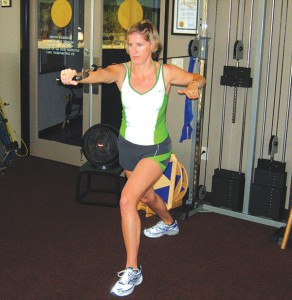
Having a plan can help you reach your goals
Many people spend a great deal of time trying to get stronger and shed those extra few pounds only to hit a wall that inhibits their progress and discourages their effort. Many go to the gym 4-5x a week with high expectations of obtaining that beach body. They watch their nutrition, drink ample water, and even go to bed early to get the proper amount of sleep for optimum recovery, adding to the frustration when results don’t appear.
So what could be the problem?
As I observe people working out at the gym and gather information from new clients, there is one thing they all have in common: They don’t have a plan.
After beginning a workout regime, sometimes a program can become stale. In a very short period of time, the body learns to adapt to the stress that is placed upon it. So if you are doing the same workouts for 3 months without changing any of the parameters, staleness sets in and the body stops growing.
Elite athletes standardly change their programs weekly as their bodies quickly become bored with the routine, and athletes at that level have a very small window to improve due to their hectic schedules. Beginners can take longer to change their programs because for the first 6-8 weeks, training is developmental meaning the nervous systems is being developed during this period and the gains are not in strength, but in neuro-development.
So to gain strength, get bigger or leaner, or to lose weight, you must have a plan and learn how to set up the variables – sets, reps, tempo intensity and rest – of a successful program. All of these factors play an important role in what you are trying to achieve, so let’s take a closer look:
Definition of terms
Sets: A set is the end result of how many repetitions that can be performed at once. Reps: The total number of times an exercise can be performed in a set. Intensity: The total amount of weight to be lifted by repetition. Tempo: The time under tension for that particular repetition. As an example, 3010 tempo means 3 seconds taken during the stretching phase; the zero means no rest at the bottom of the movement; the one refers to the contractile phase or the shortening of the muscle; and the zero at the end of the equation refers to no rest before starting another rep. Rest: The amount of time taken between sets for recovery.
Hypertrophy: This basically means you want to get bigger so you need to lift fairly heavy weight. Most jocks love this phase, but without knowing it they rarely leave this phase of training. Reps = 8-12 Sets = 3-4 Intensity = 75% of your max, Tempo = 3010, Rest = 1.5 min.
Strength: This means lifting as much weight irrespective of time with a very high intensity. So once you have gained the size that you like, it’s now time to get strong. There are many categories of strength; I will refer to Maximal Strength. Reps = 4-6, Sets = 4-6, Intensity = 85-90%, Tempo = 1010, Rest = 3-5min.
Strength/Endurance: This category fits the endurance athlete who wants to add some strength to their program, but keep the program specific to their activity level. Reps = 12-20, Sets = 3-4, Intensity = 65-70%, Tempo = 2010, Rest = 30 sec.
Power: This mode of training is for people who want to get more explosive. Lifting a weight as fast as possible in respect to time, or jumping onto a box explosively and landing softly are examples of power training. There are many theories about what the percentage of the 1 rep max should be. Keeping in mind that time is relevant when it comes to moving an object quickly and explosively. I like to use a lighter load unless the athlete can show that he or she can move the weight explosively at a higher percentage. Reps = 1-2, Sets = 4-6, Intensity = 50-85%, Tempo = xxxx, Rest = 5-6 min.
In conclusion, if you want to enjoy results from your workouts without hitting the wall, it is best to have a plan. Change the variables every week and change your exercises so you don’t become bored. The human body needs change and stress placed upon it for growth to continue. Establishing short- and long-term goals, and a plan to achieve those goals, is the key to your success with your workout routine.
Michael Butler is co-owner of Kinetix Health and Performance Center and can be reached at (760) 200.1719 or michael@kinetixcenter.com.










































Comments (0)